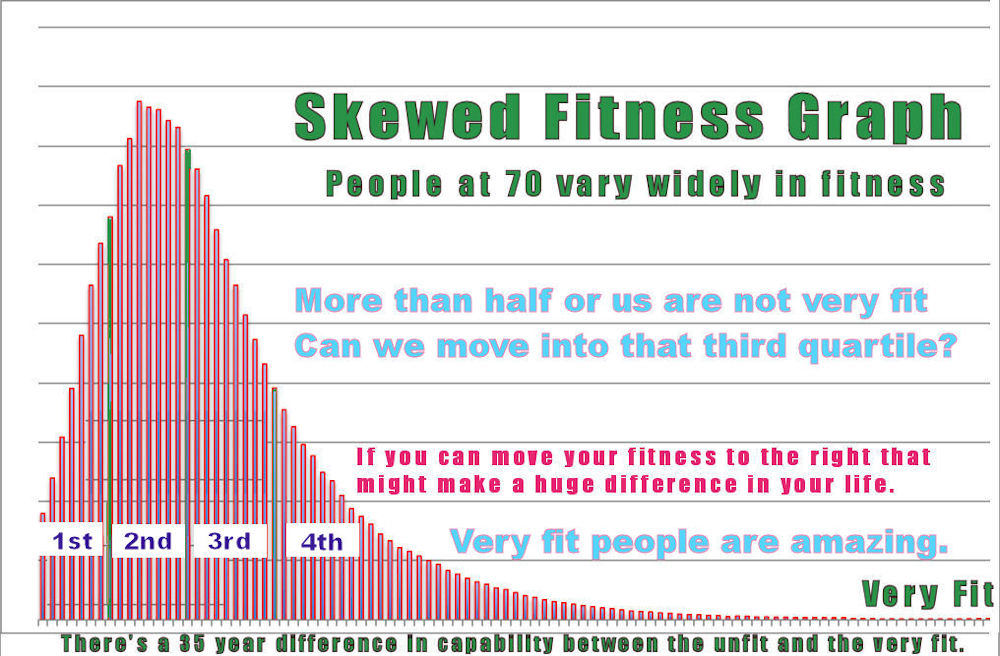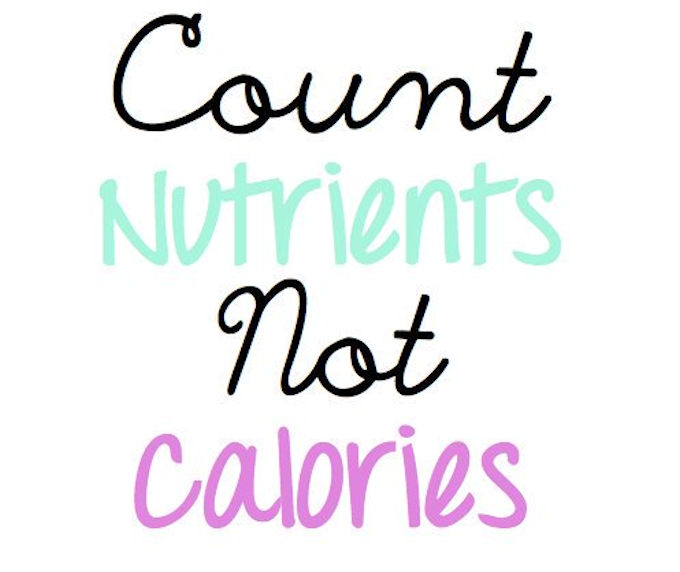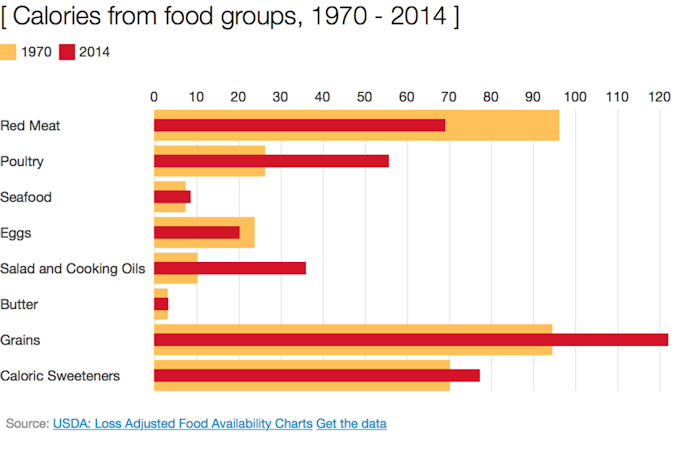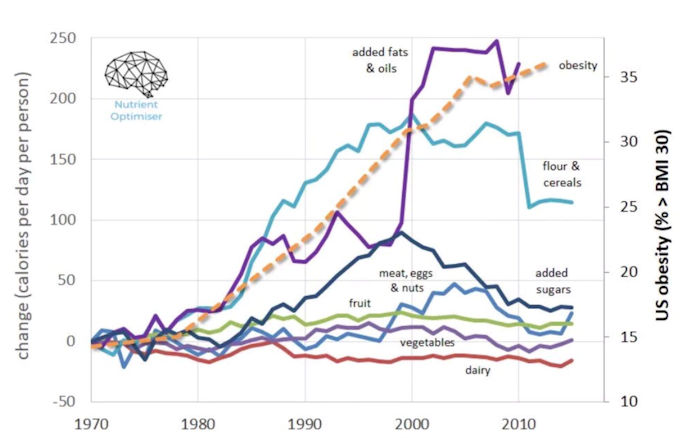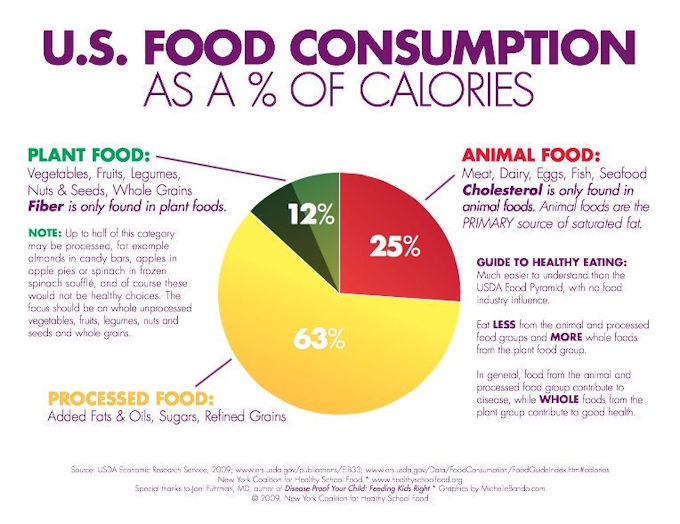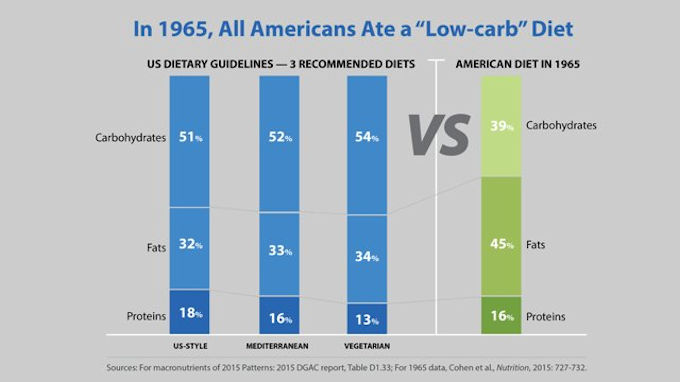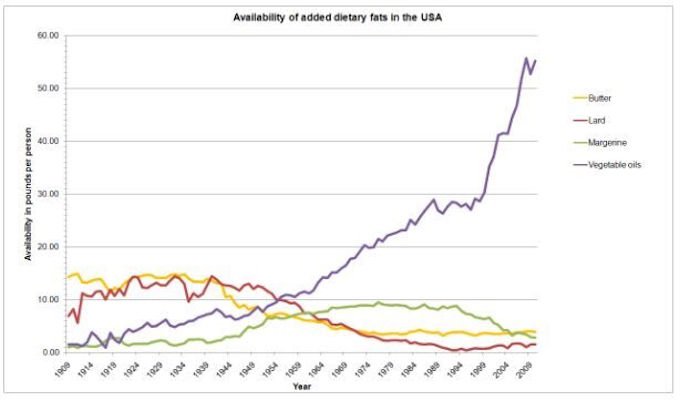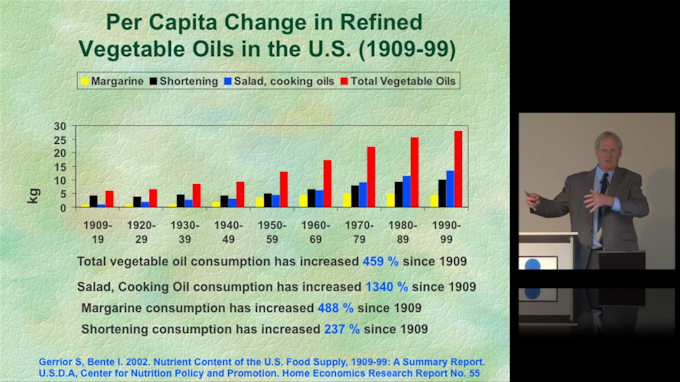
Common Health Concepts and Ideas
Nutrition and Health
Everybody knows how to be healthy! So why isn't everyone healthy?. Maybe because "fake news" isn't new.
These graphs illustrate the problem with what everyone knows about nutrition and health.
The same principles are demonstrated by two alternative research efforts
Taking and active interest in your diet and exercise makes important differences to your health.
Take an Interest in Your Own Health
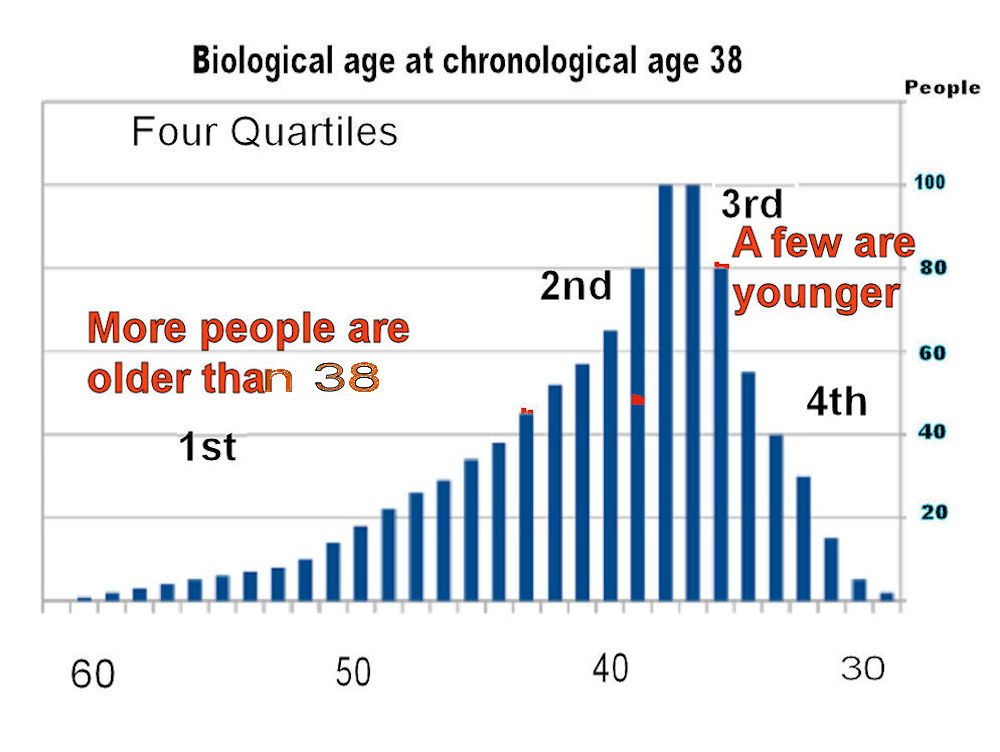
Click to Image to Enlarge
This image based on the Dunedin Study, has been horizontally flipped, so that poor health is on the left. People who are biologically older than 38.
On the right are a much smaller group who showed concern about their health, described by the researchers as "conscientious." We can't do much to shift the curve, but you can certainly shift your position on the curve, once you recognise what the problem is. Open Future Health argues that the recommended diet, has created a supermarket demand for processed foods that leaves you both hungry and lacking in nutrition. We eat more, because the poor quality of the diet leaves the body craving for proper food. Take and interest, and be active in living a healthy lifestyle.
Do Something to Improve Your Physical Fitness
Click to Image to Enlarge
In this image poor health is also on the left. Too many of us let our muscular strength decline. We need to ask why? The old principle of calories in v calories out, and that people need to exercise more, doesn't stand up. They say; "You can't run away from a bad diet," and we believe that's clearly demonstrated in our community.
Once your diet is right and AFTER you have lost some excess weight, you will feel like exercise, and your are less likely to damage your joints in the process. Since most people do very little, it's not too hard to move YOURSELF along the above graph to the right. Club cyclists in London, a group where the average age was over 75, had the physical capability of the average man half their age. You can't get that with a 30 minute stroll around the block 3 times a week. You need to put in some effort.
Excess Sugar and Carbohydrates Can be Toxic - Killing You Slowly
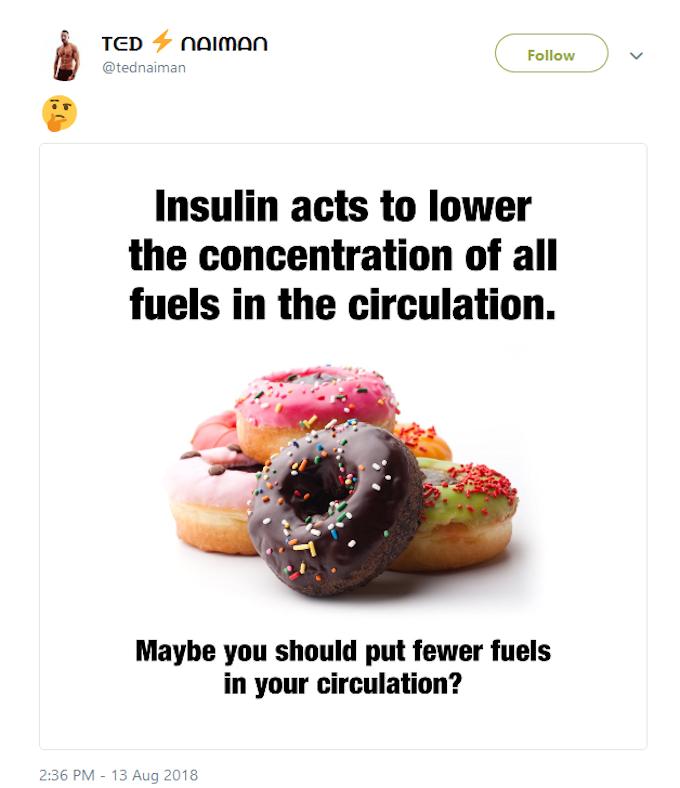
Lots of people struggle to understand what carbohydrates are. They don't usually look like sugar. Bread, pasta, potatoes, corn, rice, biscuits, fruit and anything made with flour is largely carbohydrate. Root vegetables and many other common foods, cereal and milk, fruit juice and energy bars, scroggin, soft drinks and beer, are all loaded with carbohydrate.
When eaten, sugars, including fructose and lactose, are quickly absorbed. Other carbohydrates, starches, differ from sugar in that they are arranged in long chemical chains which enzymes quickly turn into glucose in the blood. Glucose in the blood is tightly controlled, it's dangerous in excess.
These donuts contain a massive amount of energy (glucose) compared with the tiny amount that is supposed to be constant in your bloodstream (4-5gm). An iced donut has 10 times as much, and people eat more than one. That amount is toxic, and the body has a mechanism to remove the toxicity, the hormone called insulin.
Science tells us that matter can neither be created or destroyed, so what does insulin do to make the glucose go away? Insulin opens the gate to let glucose through cell walls. Once your cells are "full" emergency measures are used. Even more insulin. That's dangerous too.
High insulin forces glucose into your muscle cells, into muscle glycogen stores and into your fat cells. So long as the high glucose emergency lasts, insulin will also remain high. High insulin disables lipolysis, (The breakdown of fat for energy) and that means you cannot lose weight. Constantly high insulin starts a chain reaction that causes Metabolic Syndrome.
Your cells are already "full" but there is still excess blood glucose. Extra insulin is produced to FORCE the glucose in the blood down to normal levels. Over time that results in fatty liver disease, insulin resistance, metabolic syndrome, and obesity. The long term health results are very varied, but they are all unpleasant and entirely avoidable.
Calories In v. Calories Out - CICO - Slang Term. "Psycho"
`The recommended diet, in the USA, (And by default almost everywhere.) is low in fat (less than 30%) and high in carbohydrates (more than 55%), and 20% protein. This is called a "balanced diet". The percentages are measured in calories that very few of us understand.
Counting calories isn't a sensible approach to controlling your eating. First, you can't count calories well. Second, your bodies hormones and enzymes can't count calories either.
CICO is mathematically correct, and if the body was a mechanical device, it would work. But the body is a biological instrument, and it responds to the types of food eaten in different ways. Like you, the body doesn't know what a calorie is. Driven by hormones and other signalling metabolite's, the body can either conserve or waste the energy from the food you eat.
However, all calories (a measure of heat) are not the same what you eat and when you eat changes that signalling. If you eat foods that are quickly absorbed by the body, you end up eating "all the time" and yet always feeling hungry. That's one problem with the "balanced diet" commonly recommended.
Open Future Health recommends a Banting Diet. The Banting Diet measures foods in grams. The only grams that interest us are grams of carbohydrate a day. Less than 50. Begin the planning of each meal by choosing a quality protein, add green or coloured (above ground) vegetables, a little salt, and quite a lot of fat (preferably animal fats).
New rule. If you are not hungry don't eat. Skip meals, especially skip breakfast, the meal you never need. Since you are never hungry, when Banting, snacking stops.
Over six months or so a new eating pattern develops. Most people find that the largest meal of the day is in the evening with the family. A daily (time restricted) fast begins about 7pm. There is no supper. There is no breakfast either, but coffee, tea or water is commonly drunk. At lunch time, often more like 2pm, a small meal, mostly protein and fat will be eaten.
The length of this daily fast is important if you really want to reverse obesity or Metabolic Syndrome. The objective is to get insulin low, and keep it low for several hours. This intermittent daily fast should be for at least 12 hours, but if you can extend to 16 hours that's even better. Eat when you are hungry.
Most of us eat far too little quality protein. Eating more red meat and more fish is very helpful. We need to build muscle mass and bone strength. Eating organ meats is also nutritious. The amount of fat in the diet is far too small (so we are always hungry, and we lack essential fat soluble nutrients). Typically the carbohydrates in the diet are grossly excessive (so we have constantly high insulin, and we keep storing fat). The traditional "balanced diet" is distinctly unhealthy.
Dietary Salt - Lower is Better?
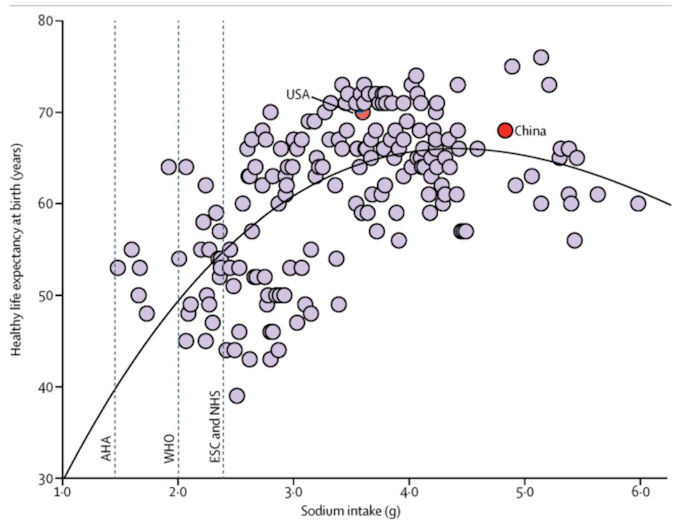
Click to Image to Enlarge
A Very low salt is harmful, especially in a Banting or Low-Carb diet. Salt to taste.
A low salt diet is said to be protective for people who have high blood pressure. This is the recommendation of the AHA, the WHO and the NHS. The concern is about blood pressure.
People on a Banting Diet tend to excrete salt, and are likely to be short of both sodium and potassium. On a Banting Diet blood pressure generally normalizes, and triglycerides fall dramatically.
If you study the graph above, you will see that the authorities all recommend a low salt diet. But the graph shows that a higher salt diet is better. OFH recommends that on a Banting Diet people eat more salt than usual. If you are not eating much meat you may need a magnesium supplement too.
Did People Follow the Dietary Guidelines?
The public did follow the guidelines. They ate more whole grains. They rejected saturated fats in favour of poly-unsaturated oils. They ate less red meat. They did not meet the expectation of the dietitians for the consumption of vegetables and fruit.
Dietitians often complain the people are not doing what the US Dietary Guidelines recommend.
Click to Image to Enlarge
Click to Image to Enlarge
Changes in foods consumed - USA - 1970 to 2015
Click to Image to Enlarge
There is a clear plant based bias in this presentation.
Click to Image to Enlarge
The diet in 1965 was more healthy than the modern diet. More fat, more red meat, more animal sourced foods. Much less carbohydrate, and very little processed carbohydrates. No supermarkets. People mostly cooked and ate at home.
These two charts show that the public understood the message about the low-fat diet, and that saturated fats were to be avoided, and lot of poly-unsaturated oils were used. Added sugar fell steeply. After 2000 meat and eggs declined too. As expected if fat consumption goes down carbohydrate consumption must go up. See the increased consumption of flour and cereals on the graph. Vegetables, fruit and dairy food remained stable. So based on this simple metric, people did attempt to follow the guidelines.
Dietitians argue the opposite, that people eat far too much sugar, and much less fruit and vegetables than they would prefer. People have increased the amount of grain they are eating, but dietitians say that they don't eat whole-grains. Of course, following what we think is a bias in nutritional advice, most dietitians think we have always eaten too much meat.
Dietitians say that we need to eat a diet with much less red meat and fewer eggs. That plant based diets are suitable for people of all ages, and should be encouraged. People should eat less saturated fats and more vegetable and seed oils.
In fact red meat is particularly nutrient dense, the natural fat of animal foods contains fat soluble vitamins and minerals that are often lacking in human diets.
OFH believes that it's sugar and more generally carbohydrates, that in fact drive obesity, and high triglycerides, and make for a higher risk for CVD.
Vegetable Oils - Saturated Fats are Bad Fats?
In particular, animal fats are higher in omega 3 fats, while vegetable based oils tend to be high in omega 6 oils. Both are essential. But before the production of seed oils was possible the balance of omega 3 and omega 6 oils was roughly, 50/50. Today the low cost of omega 6 oils has resulted in them being excessive in our diet, with adverse health consequences.
Click to Image to Enlarge
Vegetable oils were supposed to be healthy. "Heart Protective" we were told.
Oil Sales in the USA - 1909 to 1999
Click to Image to Enlarge
There is a simple test for fats and oils. All natural fats and oils are a mixture, natural fats don't exist except in a mixed state. That's unlike laboratory examples. If the substance is solid at room temperature, the chemical bonds in it are mostly connected, bound together, like a brick wall. Those fats are mostly saturated, likely to be animal based and contain some omega 3 fatty-acids. On the other hand if the fat is liquid at room temperature, there are more mono-unsaturated fats, and poly-unsaturated fats, the oil likely to be plant based and higher in omega 6 fatty acids.
We were told that the mono-unsaturated fats, and poly-unsaturated fats would reduce our LDL-cholesterol and protect us from heart disease. That is a mixed message, true enough, but probably irrelevant. LDL-cholesterol is associated with cardio-vascular disease, but it's not the cause. After 40 years vegetable oils, particularly seed oils are now seen to be causing many adverse health outcomes.
The Diet-Heart Hypothesis says that a low fat diet protects your heart from artery clogging plaques. If you eat the healthy balanced diet recommended by the Ministry of health you will live longer and enjoy life more. Saturated fats, being solid, were considered bad fats. Extensive efforts to prove this in research (Like the WHI) have failed, it's simply not true.
More importantly, the rise in the consumption of vegetable oils has changed the availability of essential fatty acids in the body. These are the raw materials that build cell walls and the myelin sheath that protects your nerve cells. Omega 6 fatty acids are perhaps 15 times more available than they used to be. When cell walls are built, or repaired, (any cell membrane in the body) if the mix of available fats is sub-standard, the cell walls that are build will be sub-standard. The system is not being built with the materials our DNA expected to be available.
Further reading
Here are Eight more Useful Preparation Pages
 What is the Best Dietary Pattern for Humans? (Includes OFH Video Three)
What is the Best Dietary Pattern for Humans? (Includes OFH Video Three)
 Metabolism, Insulin Resistance and Mental Health
Metabolism, Insulin Resistance and Mental Health
 Preserving Bone and Muscle Strength
Preserving Bone and Muscle Strength
 What Causes Type II Diabetes? Obesity?
What Causes Type II Diabetes? Obesity?
 Understanding Private and Professional Dissonance
Understanding Private and Professional Dissonance
 The Search for Evidence Based Medicine.
The Search for Evidence Based Medicine.
 Forbidden Conversations - Family Silence - My Health is My Business Includes OFH Video Two
Forbidden Conversations - Family Silence - My Health is My Business Includes OFH Video Two
 Lifestyle Changes. Nutrition First, then Exercise.
Lifestyle Changes. Nutrition First, then Exercise.

©Open Future Limited, April, 2020
16 April, 2020




